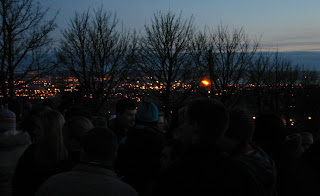Another one of those rare occasions tonight when we made an appointment with the box in the corner to watch some TV as it happened ... well, as a hard drive on Ormeau Avenue played out a pre-recorded show.

Tonight was the long anticipated broadcast of the first of three Blueprint programmes, looking at the physical history of Ireland. William Crawley and his red-coated experts exploring the land we live on, peeling back its layers, and telling the story of its development over millions of years.
(Given that the filming took place over more than a year, it did leave me wondering just how many pairs of the same pale trousers and dark jacket that William has hanging up in his wardrobe, all slightly differently torn and grubby!)
Fossils from northern and southern hemispheres found near each other, the sound of tectonic plates crashing together (though I was never sure where to look when the plates were being animated), a wonderful world map carved in the sand*, amazing revelation that there are active saltmines in under Carrickfergus**, pictures of otherwise sensible scientists like Emily Murray walking too close to the crashing waves, and a blue CGI grid that kept appearing to keep the visual narrative as the programme hopped from location to location. (The grid did cleverly mirror some of the shots of fields in the Glens of Antrim.)

After a slowish start, the production (and the land) warmed up. As one with a scientific bent but an aversion to natural history programmes, it held my attention throughout. Until, suddenly ten minutes from ten o’clock it abruptly ended. With the threat of an ice age, the titles calmly rolled up the screen (jittering a bit while someone cut to the wrong feed) and then rolled to their conclusion. A fizzle rather a climb up to a glorious conclusion.
But a great start to the new regular local programming slot at 9pm on Monday nights ... we'll be back next week (and it’s repeated on BBC Two on Wednesday at 7pm if you missed it) and perhaps we'll drop in on the companion show Off the Beaten Track on BBC Two on Thursday at 7pm to wander a mile or two with Darryl Grimason over some of the spots that were mentioned tonight. (For the really keen, Radio Ulster are doing what radio does best, and drilling into Ireland’s landscape history in more detail with Blueprint: Geology on Saturday morning at 11.30am. Plug ends.)
* second favourite bit; ** most favourite bit - if it had been broadcast tomorrow, I'd have said salt mines under Carrick counted as an April Fool!
Then from the sub-lime to the ridiculous. On The Air, the clay animation that brings visual life to real conversations from Gerry Anderson’s morning radio show. Hard to remember and believe sometimes that these aren’t made up. Gerry putting a couple of she goats in touch with a buck.
And then onto another potential seismic shift (as Blueprint might have phrased it). Zimbabwe. With the intrepid John Simpson telling the story for The Ten O'Clock News from within the country (along with other BBC colleagues like Ian Pannell getting less name checks on air - ITN have teams inside Zimbabwe too) though not yet on camera.
And George Alagiah standing at the South Africa/Zimbabwe border, poised to rush across to anchor news reports from the capital, if and when the opposition is declared to have won the election.
And after one of the most animated weather reports I’ve ever seen – Daniel Corbett practically conducted the weather as it flowed across the animated map (maybe it's the result of his US influence) – it was over to Newsnight where the talk was of the potential for peaceful protests, that would almost certainly invite military response and provoke violence.
An unnatural delay in declaring the results, leading to suspicion and uncertainty. Result rigging? Difficulty finding someone to tell President Robert Mugabe that he’s lost by a significant margin? Votes genuinely close leading to secret recounts? No one yet knows.
But the result, and the next few days, will be long-remembered in southern Africa’s history … alongside the initial hope that Mugabe brought Zimbabwe, latterly replaced by military might, corruption and despotic tendencies. The kind political epitaphs will tell of Zimbabwe’s literacy rate of 90% - the highest in Africa. But the broader analysis will point to 100,000% inflation, mass unemployment, and a life expectancy that only reaches half way to three score years and ten.


































